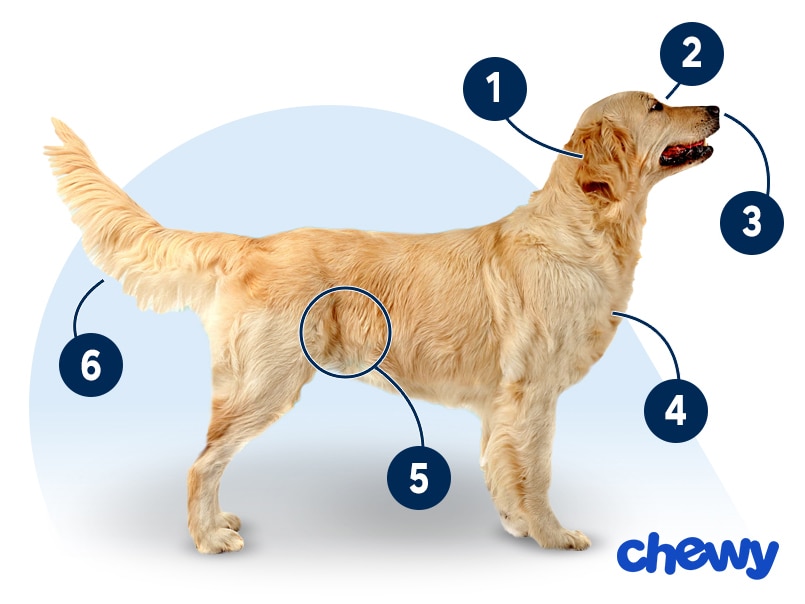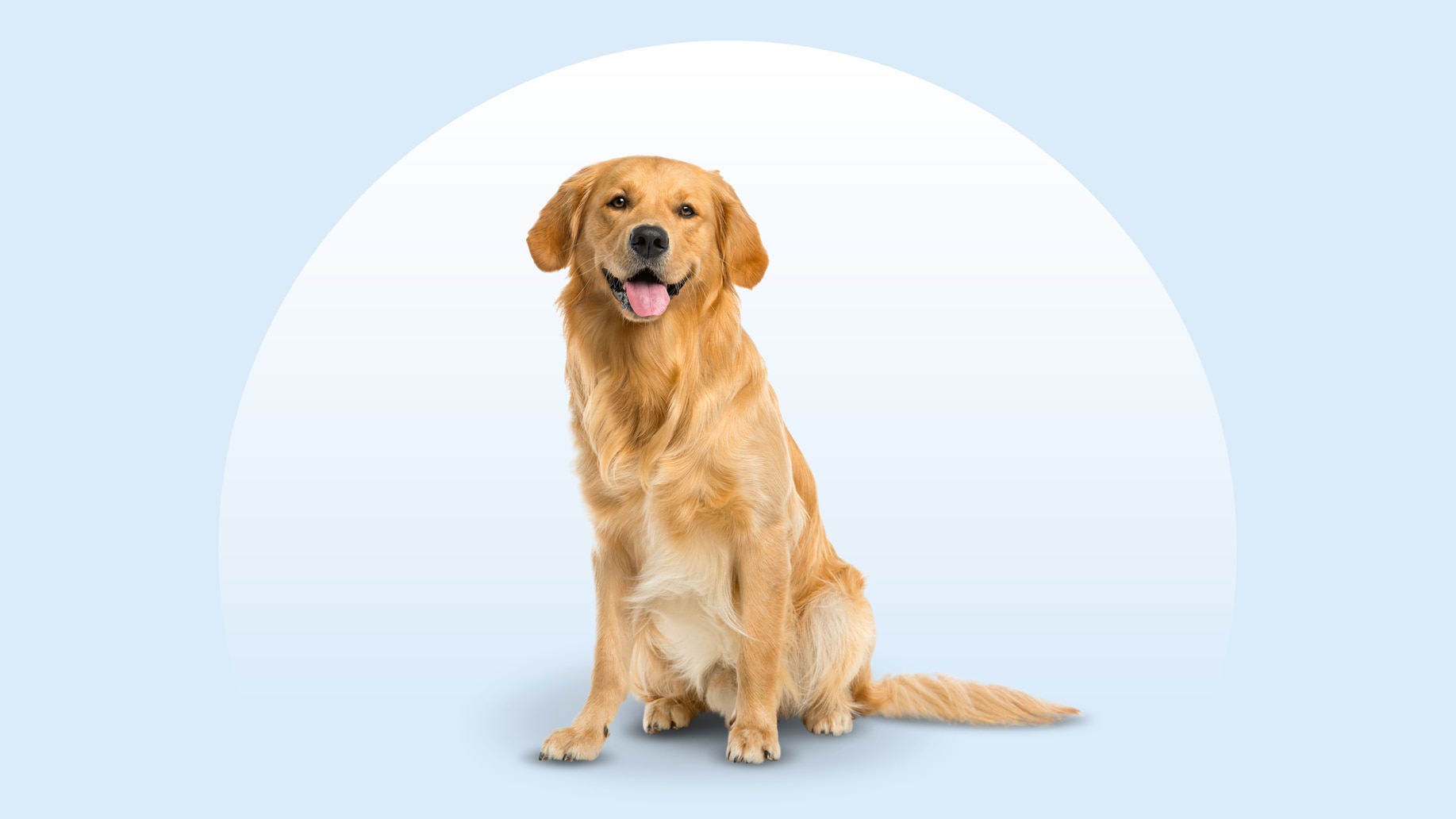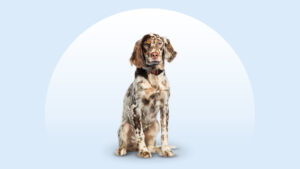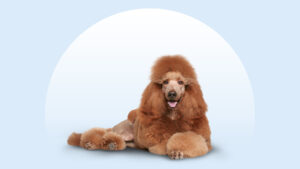Golden Retriever
Updated December 15, 2025
Golden Retriever
Updated December 15, 2025
Known for their happy-go-lucky attitude, Golden Retrievers just want to have fun—and take you along for the ride. Bright and adaptable, these long-haired pups do well with pet parents who prioritize love and attention and don’t mind a Golden’s adorably goofy antics.
Smart, Silly, Social
55–75 pounds
21.5–24 inches
10–12 years
Dark Golden, Golden, Light Golden
A Golden Retriever is like the most popular kid in high school—friendly, funny, and athletic (with great hair). Everyone knows and loves them, and it’s easy to see why: They’re social butterflies who not only soak up the spotlight, but they also shine it back on the people they love.
These clever, silly pups adore their person just as much as they enjoy a challenging game of fetch, and they’ll be your most loyal fan as long as you’re theirs, too.
Golden Retriever Characteristics
Golden Retriever Appearance
Golden Retrievers exude a healthy confidence. They carry themselves proudly, with tails happily wagging and noses always sniffing out new adventures.
Their feathered coats may be various shades of gold, from light to dark. As they age, some Golden Retrievers even develop a wise white-golden hue across their face.

- Ears
A Golden Retriever’s V-shaped floppy ears cover their ear canals.
- Eyes
Their eyes are medium or dark brown, and they have a welcoming, intelligent gaze.
- Nose
Golden Retriever noses are usually black or brown. Their pigment may fade in cold weather, turning the tip pink—a harmless phenomenon known as “snow nose.”
- Coat Length
Golden Retrievers have a medium-length double coat with two layers: a soft, insulating undercoat and a thick, water-resistant outer coat. They typically have feathering on their legs, belly, and tail.
- Coat Color
The American Kennel Club (AKC) recognizes dark golden, golden, and light golden as standard Golden Retriever colors, but coats also exist in shades from cream to deep red. For example, English Cream Golden Retrievers are simply Golden Retrievers who have been selectively bred for a light-colored coat.
- Tail
Goldens have a long, feathery tail known for its lively, upbeat wags.
Golden Retriever Temperament
Golden Retrievers are naturally outgoing and want to make you happy. Most love humans and outings, so they’ll thrive in homes with bustling environments and lots of people.
Born to mingle, your Golden will see everyone as a new best friend—and as a fetch partner. (There’s a reason they’re obsessed with tennis balls.) That wholesome, friendly personality—coupled with their moderate weight and height—make them excellent family dogs, even with small children.
Nevertheless, use caution when introducing any dog to a new home, and teach your kids how to respectfully play with their newest canine sibling.
You’re in luck when it comes to training: Bright, clever Golden Retrievers are quick learners. Originally bred to help hunters retrieve birds, their delicate retrieval allows them to carry items without applying excess pressure (great for when they pluck your favorite sweater from the laundry basket). In fact, they’re so smart that they’re often guide dogs, therapy dogs, or search-and-rescue dogs.
But one of the best things about your Golden might just be the goofy capers they get into. So, when they go to “help” unload that laundry basket, lose a sock, and get a wild case of zoomies for absolutely no reason whatsoever, enjoy the show. What’s better than a pup who makes you laugh and puts a smile on your face?
How to Care for a Golden Retriever
Golden Retrievers are adaptable and easygoing, but they’re not necessarily low maintenance. You’ll need to consider the nonnegotiables, such as daily exercise, regular brushing, and proper training, to make sure your pup is happy and healthy.
Grooming
Training
Diet
Exercise
Environment
Golden Retriever Health
These pups have a life expectancy of 10–12 years, but the Golden Retriever lifespan can vary depending on weight, fitness level, and general health. Some particularly lucky dogs can live to be 14 with no issues.
Be familiar with potential health problems so you can recognize and treat them quickly.
- Cancer: Cancer is the biggest health challenge for Golden Retrievers; one study showed that 65% of Goldens are likely to pass from cancer or cancer-related causes. The most common types seen in Goldens are lymphoma and hemangiosarcoma. Treatment may include chemotherapy, radiation, or surgery.
- Eye issues: Pigmentary uveitis occurs when cysts develop on the eye; it can lead to cataracts and glaucoma. Progressive retinal atrophy is another genetic eye condition that can cause blindness. Redness, cloudiness, bulging, squinting, or pain can all be signs that something is off with your dog’s eyes.
- Heart problems: Goldens are also prone to certain heart conditions, like subaortic stenosis. This can sometimes be detected as an audible heart murmur during a vet exam.
- Hip dysplasia: Hip dysplasia develops when the hip joint doesn’t align well and becomes looser than normal. Unfortunately, Golden Retrievers are no stranger to this condition, with the Orthopedic Foundation for Animals suggesting that as many as 19% develop it.
- Hypothyroidism: Common in Golden Retrievers, hypothyroidism includes symptoms like lethargy, hair loss, skin infections and ear infections, and weight gain. Treatment is a daily oral medication.
- Skin infections and allergies: The Golden Retriever’s thick undercoat can attract excess skin-irritating bacteria and yeast, resulting in rashes or hot spots, and it can be complicated by underlying seasonal or food allergies. Get any excessive itching or redness and rashes checked by a vet.
Golden Retriever History
Golden Retrievers were first bred in the Scottish Highlands by Dudley Marjoribanks, 1st Baron Tweedmouth (an actual real-life person and not a character on “Bridgerton”). Marjoribanks selectively bred dogs to create an energetic pup who could retrieve objects by water or land.
The first three golden retrievers were born in 1868; their parents were a Yellow Retriever and a Tweed Water Spaniel (now-extinct breeds).
Goldens arrived in the United States in the early 1900s, and they gained recognition from the AKC in 1925. Their popularity skyrocketed when President Gerald Ford brought home a Golden Retriever of his own, named Liberty.
So, how much is a Golden Retriever? Expect to pay a breeder anywhere from $1,200 to $3,500 for a Golden Retriever puppy. If you choose this route, pick a responsible breeder. You’ll also need to factor in costs for Golden Retriever puppy essentials like toys, grooming supplies, and medication.
You can also adopt a Golden Retriever, as there are lots of Golden Retriever rescue dogs waiting for homes, and they’d be grateful if you gave them a chance. Reach out to a Golden Retriever rescue or keep an eye out at your local animal shelter. You can find a local shelter through Chewy’s database of adoptable dogs.








